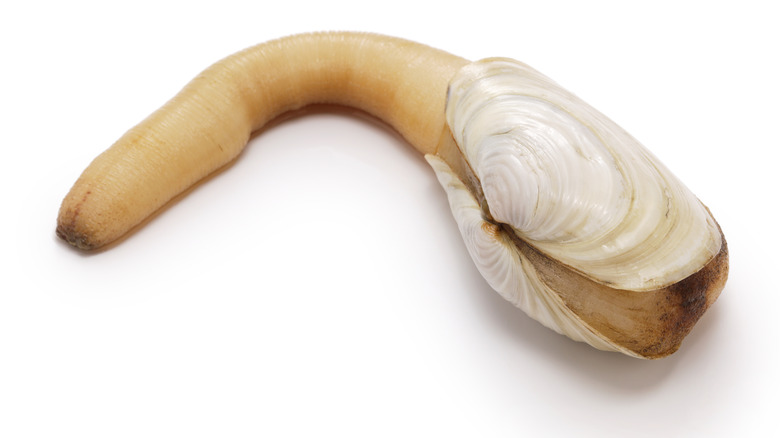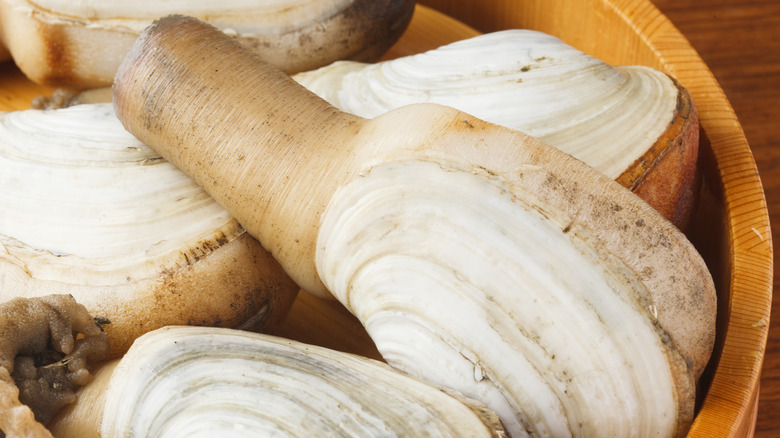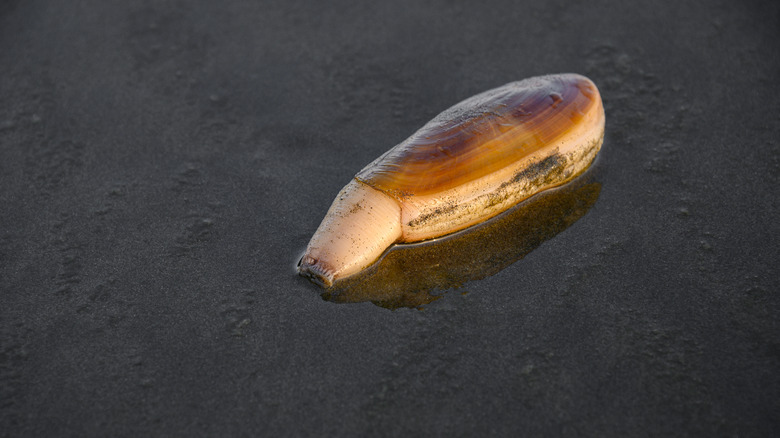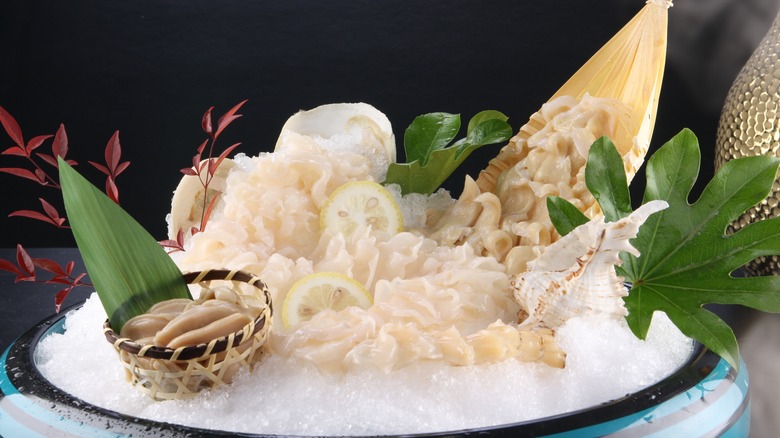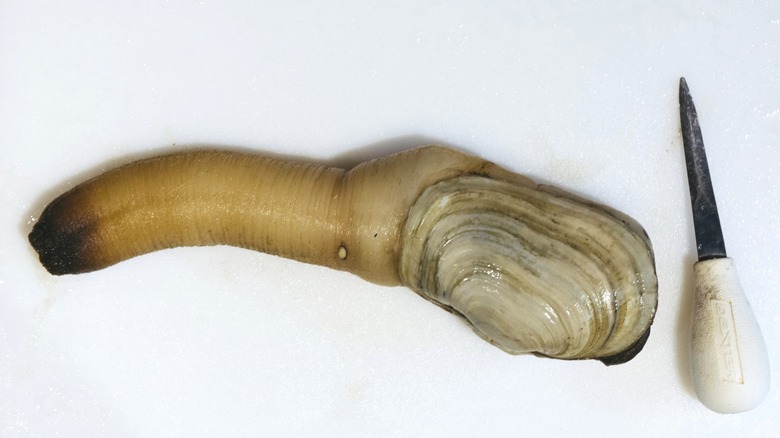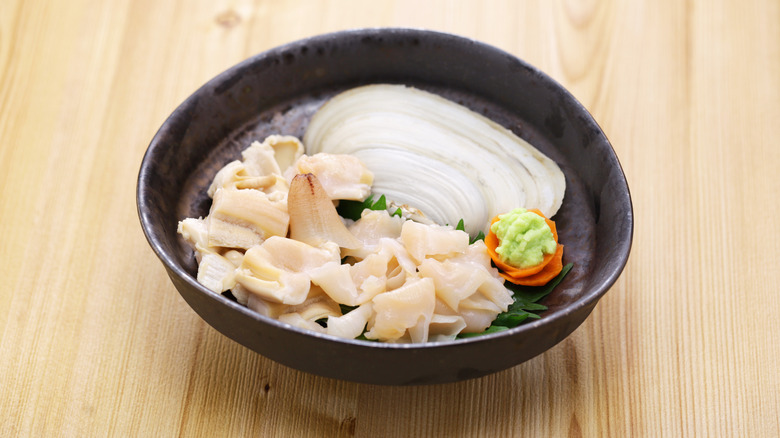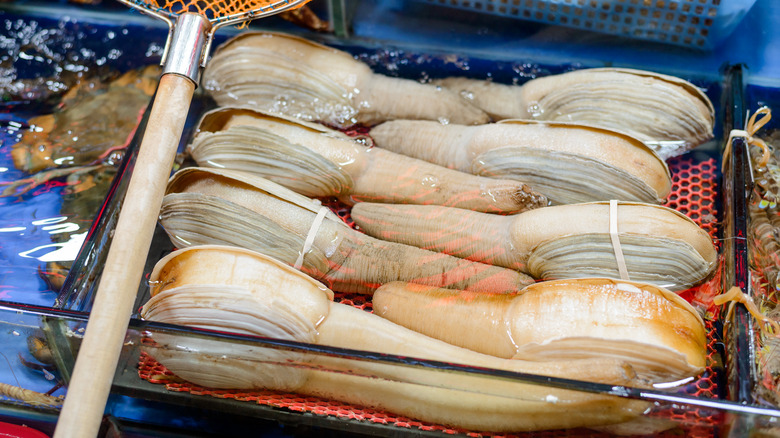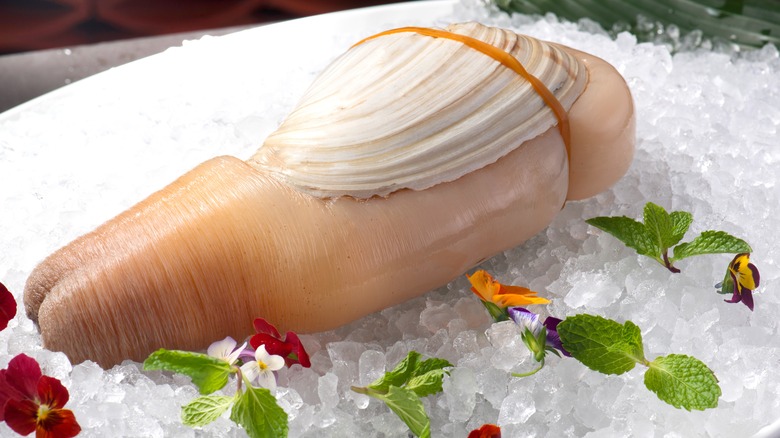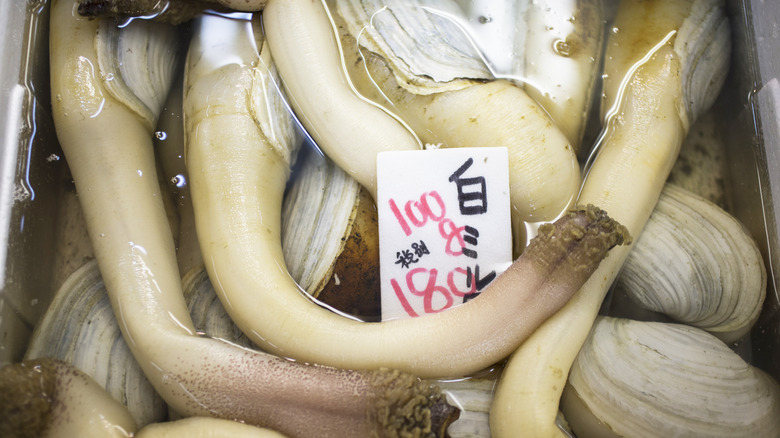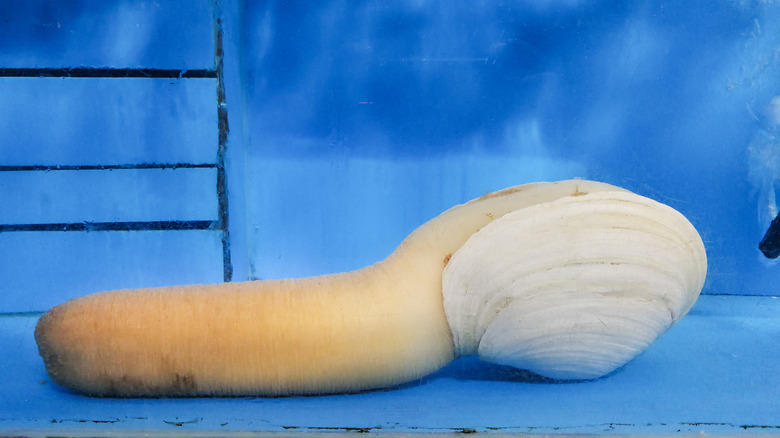What's A Geoduck And How Should It Be Cooked?
Geoduck can be confusing. When you read the name, your first thought might be "oh, it's a type of duck!" or (in the case of this writer the first time I read it) "is that a type of Pokemon?" In both cases, though, you would be wrong. But the real answer is even funnier. Geoduck, pronounced "gooey duck," just to make it even more unusual, is a huge, phallic-shaped clam found in Alaska and along the West Coast of the United States. They typically weigh from 2 to 7 pounds and can live for more than 150 years.
This saltwater clam can be eaten raw or cooked, and often appears in dishes like sashimi, stir-fries, or pan-fries. It is very popular in Washington State, where it is harvested in the wild or from large geoduck farms in Puget Sound, but it is also brings in a fortune each year when it is sold to other countries like China, where it is quite the delicacy. Intrigued yet? Read on to find out everything else you ever wanted to know about this unique, mysterious, and — let's face it — also kind of silly-looking clam.
What is a geoduck?
Geoduck may go by many names, including Elephant Clam, King Clam, Gweduck, Goiduck, and Goeduck, but whatever you call it, it is a saltwater clam from America's Pacific Coast. Its body consists of a 6- to 8-inch shell and a long, thick siphon that can grow to 3 feet long and serves as a sort of neck. This "neck" has two openings, the first of which helps it to pull in phytoplankton and oxygen from the water and the second of which expels the water it doesn't need.
Geoducks get their name from a Lushootseed Native American word that means "dig deep," which is exactly what you will have to do to harvest them. They burrow deep down into the sediment of a water source, moving down approximately 1 foot per year before settling at around three feet beneath the surface. These strangely-shaped creatures can reach 7 pounds in their first 15 years of life, but are often harvested and eaten when they are smaller (as in, around "just" 2 or 3 pounds).
Geoduck vs Pacific razor clam
Clam connoisseurs may see the image at the top of this article and squint their eyes in suspicion. "Isn't that just an oversized razor clam?" they may ask. This is an easy mistake to make, as Pacific razor clams do have a lot in common with the much girthier geoduck. They are both found around the same areas in Washington, Alaska, and other sites along America's West Coast, and they both have a long neck-like structure that comes out of a large shell. There are some important differences between them, though.
Whereas the geoduck, the largest burrowing clam in the world, can be several feet long, Pacific razor clams from the Washington area are an average of 3 to 6 inches long with a rare maximum of around 7 inches. Razor clams found in Alaska may grow to a size just short of 1 foot, but they still can't match the geoduck in length. They also can't compete with the geoduck's lifespan either. Geoducks can live to be over 100 years old, but Washington razor clams usually top out at five years while their Alaskan cousins live to the ripe old age of 15. The latter is best used in chowders and ceviche or either fried or steamed, while the former is usually served raw, fried, or in a hot pot.
What does geoduck taste like?
Not only is geoduck prized for its suggestive appearance, but it is also considered to be one of the tastiest clams on the market. Its meat is salty, as is expected with saltwater clams, but it is also sweet. It doesn't come off as overly "fishy," and the neck has a nice, crisp consistency that is a welcome relief for those who don't enjoy the mushiness of some other clams.
Typically, meat from the siphon/neck is white while meat from the body is a bit darker and a bit more tender. The latter may also have a tangier flavor when raw, but a milder, richer flavor when cooked. Both types of meat tend to take on a tougher consistency when they are cooked, which is another reason why geoduck is almost always eaten raw or very close to it, with just a light saute' or very quick searing.
How to clean geoduck
As with most seafood, there is some preparation involved before you can cook a geoduck, even if you are eating it raw. First, you have to remove the shell and skin. This can be done in two ways. The first is that you can dunk the geoduck into boiling water for around 30 seconds to 1 minute. After this, the shell should come off with ease, as should the skin of the geoduck. This method, while easy, is not considered to be the best, because it allows some of the geoduck's natural juices to be lost. It can also lightly boil the meat, which is not what you want with this clam.
Celebrity chef Andrew Zimmern's preferred way to clean a geoduck is to blacken the skin with a kitchen torch while holding the clam over a bowl to catch the drippings. Once the skin is black, you can pull it off. To remove the shell, slip a sharp knife just under the shell starting 1/4 inch from the top. Press against the hardest part of the meat to pry off the shell; repeat on the other side. Next, you should remove the geoduck's reproductive and digestive tract with that same knife, after which you can either throw them away or cook them in a soup. To finish your geoduck prep, give the now-naked clam a rinse in some cold water and you're ready to cook.
How to cook with geoduck
As we have mentioned, one of the best ways to eat geoduck is raw, particularly in the form of sashimi. Sashimi is raw fish served in very thin slices, often accompanied by pickled ginger, radish, soy sauce, or wasabi. Geoduck is also quite tasty when it is very lightly sauteed, but the key is to only cook it for a minute or so, as the longer it cooks, the tougher it gets.
This clam is ideal for dishes like Asian-inspired stir-fries with ingredients like fish sauce, garlic, and chilies, or in French-inspired dishes with browned butter and wine. Other geoduck recipe ideas include pan-fried fritters, which involve coating the meat with flour, panko breadcrumbs, garlic powder, onion powder, and spices before cooking, and geoduck ceviche, which is a dish in which raw fish is marinated in lemon or lime juice and served, salad-like, with tomatoes and peppers.
Where to buy geoduck
Unless you live in an area where it is harvested, geoduck will most likely be impossible to find at your local supermarket. It is a delicacy and, as such, tends to be both pricey (ranging from $50 to over $100 for 1 to 1.75 pounds) and difficult to find.
That being said, you can order geoduck online straight from the farms that produce it or from other seafood companies. In this case, it will usually be delivered live, so you must take the appropriate precautions and keep it in the refrigerator until you are ready to cook it. It would also be a good idea to make sure that someone is at home to accept the package when it arrives –- the geoduck won't crawl out and start taking a walk down the block, but it's not a great idea to let fresh, live seafood sit on your porch in the sun all afternoon.
Purchase Pacific Northwest Live Geoduck from Fathom Seafood.
Purchase Geoduck Clams from Hog Island Oyster Co.
Purchase Live Geoduck from Regalis.
Nutritional information for geoduck
Geoduck is actually a very nutritious clam. In addition to being a great, interesting way to up your daily dose of protein, it is also jam-packed with vitamins and minerals. With just .5 grams of total fat per 100 grams (raw), it contains much less fat than other meat and seafood options and contains just 80 calories per serving. Fish like salmon, herring, and sardines, for example, are considered to be a lot higher in fat because they contain more than 10 grams of fat per 3-ounce serving.
At 300 milligrams of sodium per 100 grams of geoduck, it is a bit high on the sodium count; the American Heart Association recommends limiting yourself to 1,500 milligrams total per day. In each 100-grams erving, geoduck also has 78 milligrams of calcium, 17 grams of protein, 30 milligrams of cholesterol, 44 milligrams of iron, and 9.1 grams of that all-essential vitamin B12.
Varieties of geoduck
While you can find geoducks all along the West Coast from Canada to California, there is not enough variation between them to make anyone wonder if they belong to a different species. However, while there is an average size among all geoducks, their individual size and coloration can change based on where they live and what the water conditions are like.
If a geoduck lives in a rockier substrate, for example, it could have a shell that is less smooth and contains chips, cracks, or other flaws. If it lives where the sediment is harder or more densely packed, it could have a darker-colored siphon or shell.
Whether the geoduck is grown on a commercial farm or in the wild can also change how it looks, as can its age, its genetic makeup, how deep it has buried itself, and how deep the water around it is. Predators can also cause damage to the shell or siphon, which can give it a unique look as well.
How to store geoduck
When it comes to storing geoduck, there is one important thing to keep in mind: Most geoduck is sold live. This may make you think that storage will be very tricky, but in reality live geoducks can be safely kept in the refrigerator with no problems. To keep them fresh, wrap them in a damp (not dripping wet) towel and store them in the lower/colder part of the fridge. It is best to cook them fairly soon after you buy them, however, so it is not advisable to leave them there for more than a couple of days.
After your geoduck is cooked, you can treat it like most other cooked seafood. To store it, place it in an airtight box or bag and put it in the refrigerator, where it can stay for around four days. Like other seafood, it is not a good idea to leave geoduck at room temperature for too long, so never let it sit out for more than two hours.
